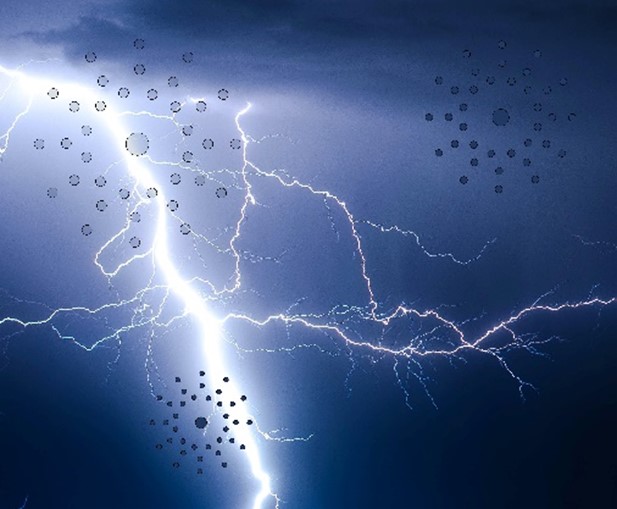A material with characteristics between crystal and glass has been accidentally created by an electrical discharge (likely a lightning strike) in the Sand Hills of Nebraska. The material is a quasicrystal with 12-fold symmetry, impossible for ordinary crystals. Transient high-pressure and high-temperature conditions seem to ease the formation of quasicrystals in nature.
Views 3034
Reading time 3.5 min
published on Sep 11, 2023
Quasicrystals are materials with a quasiperiodic atomic arrangement, meaning that their atoms are in an ordered structure, like normal crystals, but this structure does not repeat itself at regular intervals. Such atomic configuration has strong impacts on the physical properties of these materials. Quasicrystals are indeed extremely hard and show high surface slipperiness, which motivated their first commercial application to substitute Teflon for non-stick surfaces.
Around 15 years ago, we learnt that quasicrystals could be formed in nature. Indeed, they were discovered in a small piece of natural rock, which turned out to be a piece of a rare meteorite formed at the beginning of the Solar System. Further studies demonstrated that these natural quasicrystals were created in a collision among asteroids in space, in a giant impact able to produce a heterogeneous distribution of high pressure and high temperature.
To support this hypothesis, a series of laboratory shock experiments (which reproduced the conditions of the asteroidal impacts) produced quasicrystals with the same composition and structure as those found in the meteorite. So, it seemed that transient thermodynamic conditions, with highly heterogeneous pressure and temperature regimes, were needed to form quasicrystals in a natural setting.
To further explore this theory, the attention moved to other materials formed in a very peculiar environment: samples from the first atomic site, the “Trinity site” (Alamogordo, New Mexico). On 16 July 1945 at the end of the Manhattan project, the large detonation of the first nuclear device produced the so-called trinitite, a combination of glass fused from natural sand and anthropogenic copper from transmission lines used during the nuclear test. Inside one trinitite fragment a new quasicrystal was found with a chemical composition not predicted in laboratory experiments. Yet, the thermodynamic conditions that generated trinitite were very similar to those that formed natural quasicrystals in meteorites.
So the question was: Could quasicrystals be more common than thought? Given what we had learnt, they could also be the tip of a huge iceberg of novel materials to be discovered in the mineral kingdom. With this in mind, our team continued to investigate materials formed by exotic processes in nature. And the attention moved to fulgurites. These are relatively common tube-shaped, vitrified materials formed when lightning discharges into ground. Several fulgurites coming from different places around the world were studied and one, from Sand Hills (Nebraska), turned out to contain the first quasicrystal formed by electrical discharge. The Sand Hills quasicrystal exhibits 12-fold (dodecagonal) symmetry that is impossible for ordinary crystals. The 12-fold symmetry in a material formed by a natural process represents a novelty, as all the previous natural quasicrystals have 5-fold or 10-fold symmetry. It is also another example of a composition discovered in nature prior to being discovered in the laboratory and, even more important, the dodecagonal quasicrystal was formed by a completely uncontrolled process, lasting perhaps a few minutes, yet resulting in almost identical to industrial synthetic quasicrystals with similar composition.
We characterized the Sand Hills dodecagonal quasicrystal by transmission electron microscopy, a technique able to give information on the distribution of the atoms in the structure. The analysis showed that the real space structure consists of a homogeneous, quasiperiodic, and 12-fold symmetric pattern composed of dodecagonal clusters.
Overall, the Sand Hills quasicrystal has revealed a possible new approach to obtain quasicrystals by synthesis methods. Additionally, the finding of a quasicrystal formed by an electrical discharge may give information on the meteorite where the first quasicrystals were found. In particular, this could reveal the highly reducing conditions needed to explain the presence of metallic aluminium in the quasicrystals and several of the crystalline phases found in the meteorite that cannot be explained by the impacts alone. It has been recently demonstrated that intense reducing conditions can be generated by the possible presence of lightning strikes in the solar nebula. Therefore, such natural phenomena might be crucial to promote the quasicrystal formation and, who knows, also of other novel materials that have yet to be envisioned.
Original Article:
Bindi, L., Pasek, M. A., Ma, C., Hu, J., Cheng, G., Yao, N., Asimow, P. D., & Steinhardt, P. J. (2023). Electrical discharge triggers quasicrystal formation in an eolian dune. Proceedings of the National Academy of Sciences, 120(1). https://doi.org/10.1073/pnas.2215484119
 Earth & Space
Earth & Space



